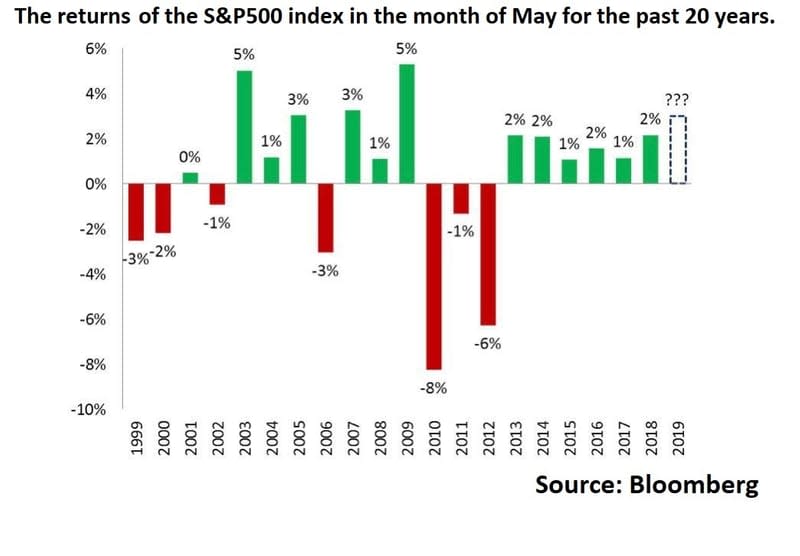Sell in May and Go Away?
I did take the trouble to have a look at the statistics on the return of the S&P500 index in the month of May for the past 20 years. As a result, I found that the market did not always fall in May. Moreover, growth was observed much more frequently, namely, in about 65% of cases. The past 6 years in a row were characterized only by market growth.
The times of low-interest rates took their toll. One of the oldest postulates of the stock market is in doubt.

Does these intriguing statistics presuppose that the market will now grow in May? Of course not. It rather shows a concurrence of circumstances and a combination of market-friendly factors.
Therefore, today there are equal chances to see the continuation of recent years’ tendency as there are to see a confirmation of the old good saying.
What should you do in the first case? Hold positions in stocks and buy new interesting ideas. In the case of the second scenario, it is time to mind the defensive assets. In fact, there are many of them: inverse ETFs (SH, SDS, DXD, SPXU), gold ETFs (GLD, IAU, SGOL), shares of gold mining companies (Barrick Gold, Newmont, etc.), and the buying volatility. Here I would like to provide more details.
VXXB (single-long) and TVIX (double-long) are the main instruments for the buying volatility. These are the notes (ETN) based on the index consisting of short VIX futures (Volatility Index of Chicago Board Options Exchange), short-term practical tools for speculation and hedging.
How does it work? Suppose you hear negative news, there is confusion in the market, and everybody is running around shouting “Nightmare!”. This would naturally lead to higher volatility. In this case, VXXB and TVIX show solid growth. Interestingly, the dynamics of TVIX is more aggressive, which is explained by the fact that it is double-long.
Seems like everything is quite simple – when the market is growing, just short the VXXB and TVIX; when the market is falling, buy and start counting your profit. However, I would like to alert my readers and give a warning to them. You need to be very careful when dealing with these instruments. What do I mean?
First, the position size should be smaller in comparison with the portfolio as a whole, in particular, not more than 10%. Secondly, in no case should you hold this position for a long time since these tools are affected by the time variable (by analogy with options, theta). If the market has been growing for a long time, it is necessary to cut down the position in volatility proactively, since a loss on this position can “gobble up” a significant part of the earnings from the growth of stocks – even despite its small share of the portfolio.

There is no direct relationship here. Suppose you bought VXXB for $40 when the S&P500 level was 2700. The market started to go up and, accordingly, your volatility position rapidly is weighing down on a portfolio. However, when the market again fell to 2700, VXXB rose to only $37. This means that even reaching the benchmark level, you still remain in the red. This is how the time variable works in VXXB and TVIX.
These instruments can and should be used. But it is important to make sure you use them in a short-term (in no case should you hold a position for too long) and do it in small volumes (not more than 10% of the portfolio).
The article was written by Evgeny Kogan, Ph.D., investment banker, the author of the telegram-channel Bitkogan.
This article was originally posted on FX Empire

 Yahoo Finance
Yahoo Finance 